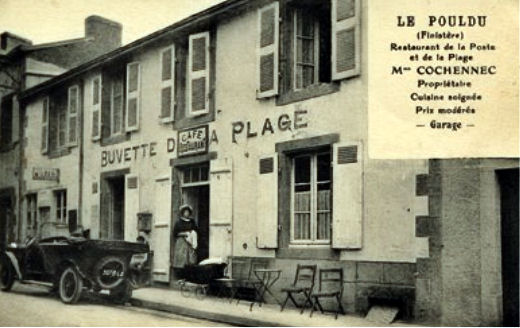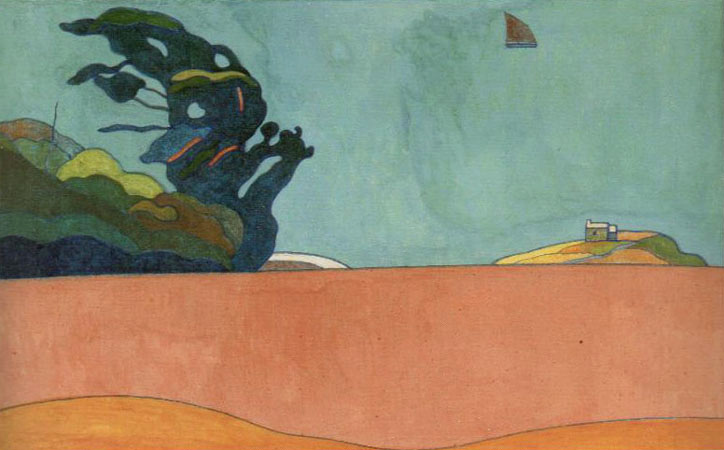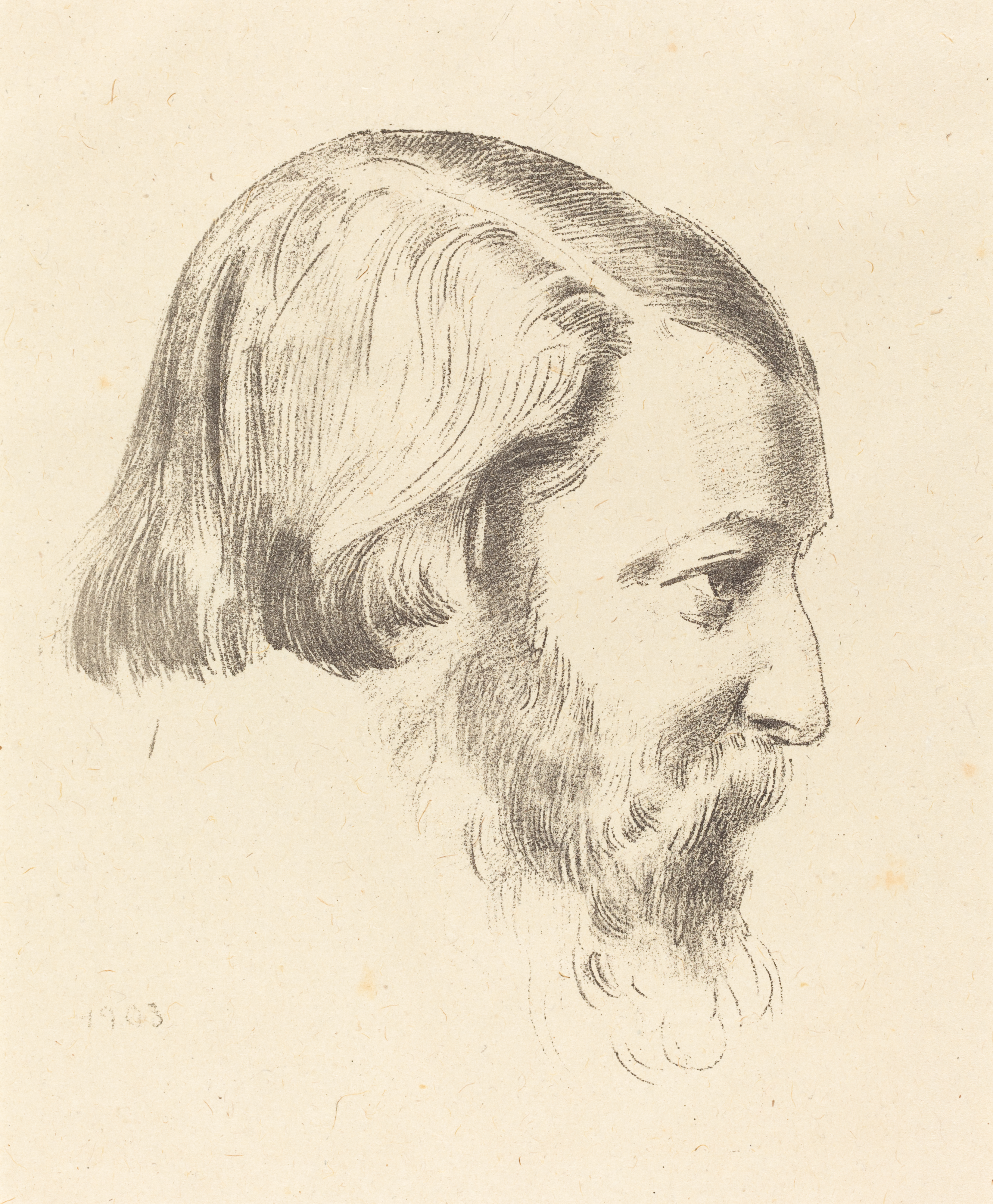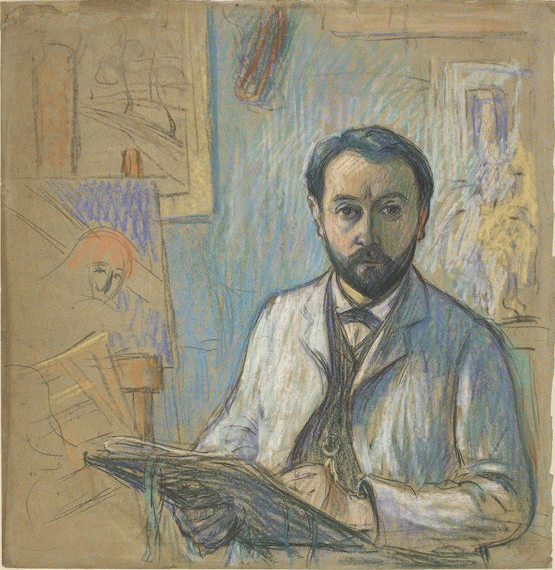|
Self-Portrait With Halo And Snake
''Self-Portrait with Halo and Snake'', also known as ''Self-Portrait'', is an 1889 oil-on-wood painting by French artist Paul Gauguin, which represents his late Brittany period in the fishing village of Le Pouldu in northwestern France. No longer comfortable with Pont-Aven, Gauguin moved on to Le Pouldu with his friend and student Meijer de Haan and a small group of artists. He stayed for several months in the autumn of 1889 and the summer of 1890, where the group spent their time decorating the interior of Marie Henry's inn with every major type of art work. Gauguin painted his ''Self-Portrait'' in the dining room with its companion piece, ''Portrait of Jacob Meyer de Haan'' (1889). The painting shows Gauguin against a red background with a halo above his head and apples hanging beside him as he holds a snake in his hand while plants or flowers appear in the foreground. The religious symbolism and the stylistic influence of Japanese wood-block prints and cloisonnism are ... [...More Info...] [...Related Items...] OR: [Wikipedia] [Google] [Baidu] |
Paul Gauguin
Eugène Henri Paul Gauguin (, ; ; 7 June 1848 – 8 May 1903) was a French Post-Impressionist artist. Unappreciated until after his death, Gauguin is now recognized for his experimental use of colour and Synthetist style that were distinct from Impressionism. Toward the end of his life, he spent ten years in French Polynesia. The paintings from this time depict people or landscapes from that region. His work was influential on the French avant-garde and many modern artists, such as Pablo Picasso and Henri Matisse, and he is well known for his relationship with Vincent and Theo van Gogh. Gauguin's art became popular after his death, partially from the efforts of dealer Ambroise Vollard, who organized exhibitions of his work late in his career and assisted in organizing two important posthumous exhibitions in Paris. Gauguin was an important figure in the Symbolist movement as a painter, sculptor, printmaker, ceramist, and writer. His expression of the inherent meaning of t ... [...More Info...] [...Related Items...] OR: [Wikipedia] [Google] [Baidu] |
Pont-Aven School
Pont-Aven School (french: École de Pont-Aven, br, Skol Pont Aven) encompasses works of art influenced by the Breton town of Pont-Aven and its surroundings. Originally the term applied to works created in the artists' colony at Pont-Aven, which started to emerge in the 1850s and lasted until the beginning of the 20th century. Many of the artists were inspired by the works of Paul Gauguin, who spent extended periods in the area in the late 1880s and early 1890s. Their work is frequently characterised by the bold use of pure colour and their Symbolist choice of subject matter. Background Pont-Aven is a commune of the Finistère '' département'', in Brittany Brittany (; french: link=no, Bretagne ; br, Breizh, or ; Gallo: ''Bertaèyn'' ) is a peninsula, historical country and cultural area in the west of modern France, covering the western part of what was known as Armorica during the period o ..., France, some distance inland from where the river Aven (river), Aven me ... [...More Info...] [...Related Items...] OR: [Wikipedia] [Google] [Baidu] |
Chalk
Chalk is a soft, white, porous, sedimentary carbonate rock. It is a form of limestone composed of the mineral calcite and originally formed deep under the sea by the compression of microscopic plankton that had settled to the sea floor. Chalk is common throughout Western Europe, where deposits underlie parts of France, and steep cliffs are often seen where they meet the sea in places such as the Dover cliffs on the Kent coast of the English Channel. Chalk is mined for use in industry, such as for quicklime, bricks and builder's putty, and in agriculture, for raising pH in soils with high acidity. It is also used for " blackboard chalk" for writing and drawing on various types of surfaces, although these can also be manufactured from other carbonate-based minerals, or gypsum. Description Chalk is a fine-textured, earthy type of limestone distinguished by its light color, softness, and high porosity. It is composed mostly of tiny fragments of the calcite shells or sk ... [...More Info...] [...Related Items...] OR: [Wikipedia] [Google] [Baidu] |
Diffuse Reflection
Diffuse reflection is the reflection of light or other waves or particles from a surface such that a ray incident on the surface is scattered at many angles rather than at just one angle as in the case of specular reflection. An ''ideal'' diffuse reflecting surface is said to exhibit Lambertian reflection, meaning that there is equal luminance when viewed from all directions lying in the half-space adjacent to the surface. A surface built from a non-absorbing powder such as plaster, or from fibers such as paper, or from a polycrystalline material such as white marble, reflects light diffusely with great efficiency. Many common materials exhibit a mixture of specular and diffuse reflection. The visibility of objects, excluding light-emitting ones, is primarily caused by diffuse reflection of light: it is diffusely-scattered light that forms the image of the object in the observer's eye. Mechanism Diffuse reflection from solids is generally not due to surface roughness. ... [...More Info...] [...Related Items...] OR: [Wikipedia] [Google] [Baidu] |
Pendant
A pendant is a loose-hanging piece of jewellery, generally attached by a small loop to a necklace, which may be known as a "pendant necklace". A pendant earring is an earring with a piece hanging down. Its name stems from the Latin word ''pendere'' and Old French word ''pendr'', both of which translate to "to hang down". In modern French, ''pendant'' is the gerund form of ''pendre'' ("to hang") and also means "during". The extent to which the design of a pendant can be incorporated into an overall necklace makes it not always accurate to treat them as separate items. In some cases, though, the separation between necklace and pendant is far clearer. Overview Pendants are among the oldest recorded types of bodily adornment. Stone, shell, pottery, and more perishable materials were used. Ancient Egyptians commonly wore pendants, some shaped like hieroglyphs. Pendants can have several functions, which may be combined: * Award (i.e., Scouting Ireland Chief Scout's Award, ... [...More Info...] [...Related Items...] OR: [Wikipedia] [Google] [Baidu] |
Gauguin Meyer De Haan
Eugène Henri Paul Gauguin (, ; ; 7 June 1848 – 8 May 1903) was a French Post-Impressionist artist. Unappreciated until after his death, Gauguin is now recognized for his experimental use of colour and Synthetist style that were distinct from Impressionism. Toward the end of his life, he spent ten years in French Polynesia. The paintings from this time depict people or landscapes from that region. His work was influential on the French avant-garde and many modern artists, such as Pablo Picasso and Henri Matisse, and he is well known for his relationship with Vincent and Theo van Gogh. Gauguin's art became popular after his death, partially from the efforts of dealer Ambroise Vollard, who organized exhibitions of his work late in his career and assisted in organizing two important posthumous exhibitions in Paris. Gauguin was an important figure in the Symbolist movement as a painter, sculptor, printmaker, ceramist, and writer. His expression of the inherent meaning of the s ... [...More Info...] [...Related Items...] OR: [Wikipedia] [Google] [Baidu] |
Polychrome
Polychrome is the "practice of decorating architectural elements, sculpture, etc., in a variety of colors." The term is used to refer to certain styles of architecture, pottery or sculpture in multiple colors. Ancient Egypt Colossal statue of Tutankhamun Paris 2019 A.jpg, Polychrome quartzite colossal statue of Tutankhamun, 1355-1315 BC Nofretete Neues Museum.jpg, Polychrome limestone and plaster ''Bust of Nefertiti'', 1352–1336 BC Composite Papyrus Capital MET 10.177.2 EGDP018080.jpg, Polychrome sandstone Composite papyrus capital, 380–343 BC Medinet Habu 2016-03-23g.jpg, Polychrome winged sun on a cavetto from the Medinet Habu temple complex, unknown date Classical world Some very early polychrome pottery has been excavated on Minoan Crete such as at the Bronze Age site of Phaistos. In ancient Greece sculptures were painted in strong colors. The paint was frequently limited to parts depicting clothing, hair, and so on, with the skin left in the natural c ... [...More Info...] [...Related Items...] OR: [Wikipedia] [Google] [Baidu] |
Charles Filiger
Charles Filiger (28 November 1863, Thann – 11 January 1928, Brest) was a French Symbolist painter. He was one of the artists who associated with Gauguin at Pont-Aven in Brittany. Biography The son of a wallpaper manufacturer in Mulhouse, Filiger first studied decorative arts before specializing in painting at the Académie Colarossi in Paris. He exhibited at the Salon des Indépendants in 1889 and 1890. He arrived in Pont-Aven in 1888 and went on to Le Pouldu staying at the Buvette de la Plage where Gauguin was also a guest. Other artists who joined the colony in the late 1880s and early 1890s included Paul Sérusier, Charles Laval, Meijer de Haan, Armand Séguin, Henry Moret and Émile Jourdan. From 1890, he received a monthly payment of 100 francs from the artists' patron Count Antoine de La Rochefoucauld who was thus able to select Filiger's best works for himself while the remainder were exhibited at Le Barc de Boutteville, Le Salon de la Rose + Croix and oth ... [...More Info...] [...Related Items...] OR: [Wikipedia] [Google] [Baidu] |
Paul SĂ©rusier
Paul Sérusier (9 November 1864 – 7 October 1927) was a French painter who was a pioneer of abstract art and an inspiration for the avant-garde Nabis movement, Synthetism and Cloisonnism. Education Sérusier was born in Paris. He studied at the Académie Julian and was a monitor there in the mid-1880s. In the summer of 1888 he travelled to Pont-Aven and joined the small group of artists centered there around Paul Gauguin. While at the Pont-Aven artist's colony he painted a picture that became known as ''The Talisman'', under the close supervision of Gauguin. The picture was an extreme exercise in Cloisonnism that approximated to pure abstraction. He was a Post-Impressionist painter, a part of the group of painters called Les Nabis. Sérusier, along with Paul Gauguin, named the group. Pierre Bonnard, Édouard Vuillard and Maurice Denis became the best known of the group, but at the time they were somewhat peripheral to the core group. In 1892 Sérusier met and befrie ... [...More Info...] [...Related Items...] OR: [Wikipedia] [Google] [Baidu] |
Sartor Resartus
''Sartor Resartus: The Life and Opinions of Herr Teufelsdröckh in Three Books'' is an 1831 novel by the Scottish essayist, historian and philosopher Thomas Carlyle, first published as a serial in '' Fraser's Magazine'' in November 1833 – August 1834. The novel purports to be a commentary on the thought and early life of a German philosopher called Diogenes Teufelsdröckh (which translates as 'God-born Devil's-dung'), author of a tome entitled ''Clothes: Their Origin and Influence''. Teufelsdröckh's Transcendentalist musings are mulled over by a sceptical English Reviewer (referred to as Editor) who also provides fragmentary biographical material on the philosopher. The work is, in part, a parody of Hegel, and of German Idealism more generally. Background Archibald MacMechan surmised that the novel's invention had three literary sources. The first of these was '' A Tale of a Tub'' by Jonathan Swift, whom Carlyle intensely admired in his college years, even going by the nick ... [...More Info...] [...Related Items...] OR: [Wikipedia] [Google] [Baidu] |
Émile Schuffenecker
Claude-Émile Schuffenecker (8 December 1851 – 31 July 1934) was a French Post-Impressionist artist, painter, art teacher and art collector. A friend of Paul Gauguin and Odilon Redon, and one of the first collectors of works by Vincent van Gogh, Schuffenecker was instrumental in establishing The Volpini Exhibition, in 1889. Biography Claude-Émile Schuffenecker, son of Nicolas Schuffenecker (1829–1854) and Anne Monnet (1836–1907) was born in Fresne-Saint-Mamès ( Haute-Saône). His father, a tailor originating from Guewenheim ( Alsace, today Haut-Rhin), died when Émile was little more than two years old; the same year his brother Amédée was born in Charentenay (Haut-Rhin). The widow with her two boys moved to Meudon, close to Paris, where part of her mother's family lived, and where she had found work at a laundry. In the years to follow Émile was raised by his mother's sister, Anne Fauconnet Monnet, and her husband Pierre Cornu in Paris, educated by the Fr ... [...More Info...] [...Related Items...] OR: [Wikipedia] [Google] [Baidu] |



%2C_Western_Negev%2C_Israel.jpg)






